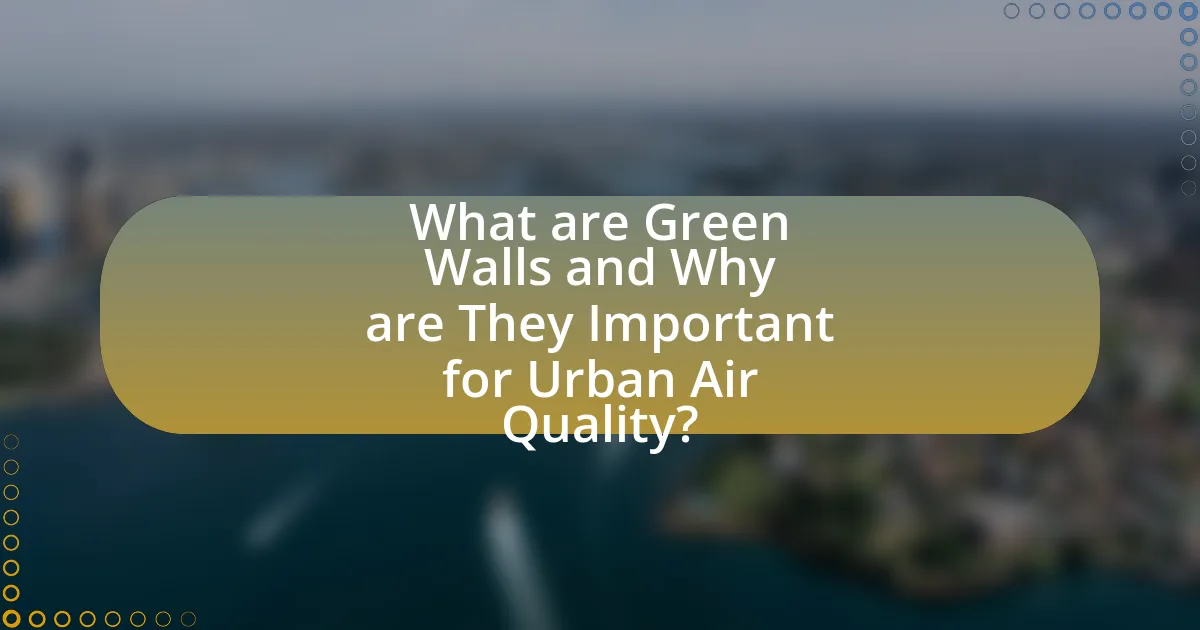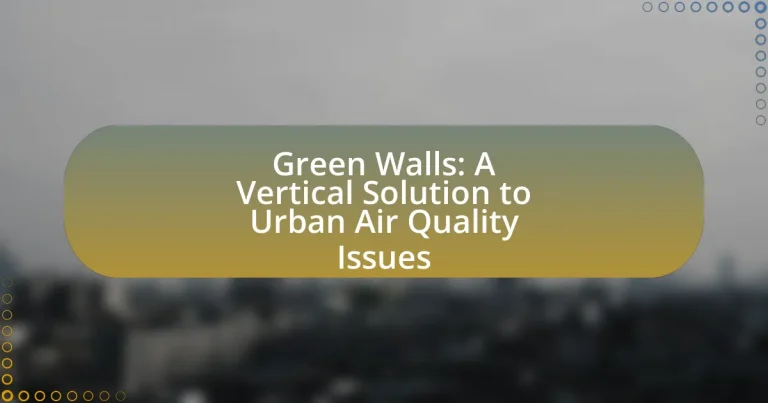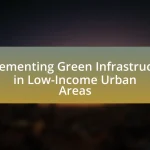Green walls, also known as vertical gardens, are structures that incorporate living plants on vertical surfaces, playing a crucial role in enhancing urban air quality. They effectively reduce air pollutants such as particulate matter and carbon dioxide while increasing oxygen levels, with studies indicating a potential reduction of airborne particulate matter by up to 60%. The article explores how green walls contribute to improved air quality, mitigate specific pollutants, interact with urban microclimates, and enhance biodiversity. It also discusses various types of green walls, their economic advantages, challenges in implementation, and the role of community engagement in their maintenance. Additionally, emerging trends and technological innovations in green wall design and maintenance are examined, highlighting their significance in addressing urban environmental issues.

What are Green Walls and Why are They Important for Urban Air Quality?
Green walls, also known as vertical gardens, are structures that incorporate living plants on vertical surfaces, either indoors or outdoors. They are important for urban air quality because they can significantly reduce air pollutants, such as particulate matter and carbon dioxide, while increasing oxygen levels. Studies have shown that green walls can improve air quality by filtering harmful substances and providing a cooling effect, which can mitigate urban heat islands. For instance, research published in the journal “Environmental Science & Technology” indicates that green walls can reduce airborne particulate matter by up to 60%. This demonstrates their effectiveness in enhancing urban environments and promoting healthier air quality for city residents.
How do Green Walls contribute to improving air quality in urban areas?
Green walls contribute to improving air quality in urban areas by absorbing pollutants and carbon dioxide while releasing oxygen through the process of photosynthesis. These vertical gardens can reduce particulate matter and volatile organic compounds in the air, effectively filtering harmful substances. Studies have shown that green walls can lower ambient temperatures, which in turn reduces the formation of ground-level ozone, a significant air pollutant. For instance, research published in the journal “Environmental Science & Technology” indicates that green walls can remove up to 60% of particulate matter from the air, demonstrating their effectiveness in enhancing urban air quality.
What specific pollutants can Green Walls help mitigate?
Green walls can help mitigate specific pollutants such as particulate matter (PM10 and PM2.5), nitrogen dioxide (NO2), sulfur dioxide (SO2), and volatile organic compounds (VOCs). Research indicates that plants in green walls absorb these pollutants through their leaves and roots, effectively improving urban air quality. For instance, a study published in the journal “Environmental Science & Technology” found that green walls can reduce PM concentrations by up to 60% in urban environments, demonstrating their effectiveness in pollutant mitigation.
How do Green Walls interact with urban microclimates?
Green walls interact with urban microclimates by moderating temperature, improving air quality, and enhancing humidity levels. These vertical gardens provide insulation, which can reduce the urban heat island effect by lowering surface and air temperatures in densely built environments. Studies indicate that green walls can decrease surrounding air temperatures by up to 5 degrees Celsius, contributing to cooler urban areas. Additionally, they filter pollutants and particulate matter from the air, improving overall air quality. Research has shown that plants in green walls can absorb carbon dioxide and release oxygen, further enhancing the microclimate. Furthermore, green walls increase humidity through evapotranspiration, which can mitigate dry conditions often found in urban settings.
What are the different types of Green Walls?
The different types of green walls include living walls, modular green walls, and green facades. Living walls consist of a structural system that supports a variety of plants, often using soil or hydroponic systems for growth. Modular green walls are pre-planted panels that can be easily installed and replaced, allowing for flexibility in design and maintenance. Green facades involve climbing plants that grow on a support structure, utilizing the existing building surface for growth. Each type contributes to improving urban air quality by filtering pollutants and providing insulation, thus supporting the overall goal of enhancing environmental health in urban settings.
What are the differences between living walls and green facades?
Living walls and green facades differ primarily in their structure and plant integration. Living walls, also known as vertical gardens, consist of a modular system that supports plants directly in a soil or hydroponic medium, allowing for a diverse range of plant species to thrive in a controlled environment. In contrast, green facades involve climbing plants that grow on a support structure, such as trellises or cables, where the plants typically root in the ground rather than in the wall itself. This distinction is significant as living walls often require more maintenance and irrigation systems, while green facades rely on the natural growth patterns of climbing plants.
How do modular systems compare to traditional Green Wall installations?
Modular systems offer greater flexibility and ease of installation compared to traditional Green Wall installations. While traditional systems often require extensive structural support and are typically more labor-intensive, modular systems can be prefabricated and easily assembled on-site, reducing installation time and costs. Additionally, modular systems allow for easier maintenance and replacement of individual plant modules, which enhances their sustainability and adaptability in urban environments. Studies indicate that modular green walls can improve air quality by effectively filtering pollutants, similar to traditional systems, but with the added benefit of being more user-friendly and efficient in urban settings.
What are the key benefits of implementing Green Walls in cities?
Implementing Green Walls in cities provides significant benefits, including improved air quality, enhanced biodiversity, and energy efficiency. Green Walls act as natural air filters, absorbing pollutants and carbon dioxide while releasing oxygen, which contributes to cleaner urban air. Studies indicate that vegetation can reduce particulate matter by up to 60%, thereby improving respiratory health for city dwellers. Additionally, these vertical gardens support various species, promoting urban biodiversity and creating habitats for birds and insects. Furthermore, Green Walls can insulate buildings, reducing energy consumption for heating and cooling by up to 30%, which leads to lower greenhouse gas emissions.
How do Green Walls enhance biodiversity in urban environments?
Green walls enhance biodiversity in urban environments by providing habitats for various plant and animal species. These vertical gardens create microhabitats that support pollinators, birds, and beneficial insects, contributing to increased species diversity. Research indicates that green walls can host a variety of flora, which in turn attracts fauna, thereby fostering ecological interactions. For instance, a study published in the journal “Urban Ecosystems” found that green walls can increase local biodiversity by up to 30%, demonstrating their effectiveness in urban settings where natural habitats are limited.
What economic advantages do Green Walls provide to urban areas?
Green walls provide significant economic advantages to urban areas by enhancing property values and reducing energy costs. Studies indicate that buildings with green walls can see property value increases of up to 20%, as they are perceived as more attractive and environmentally friendly. Additionally, green walls improve insulation, leading to reduced heating and cooling costs by approximately 30%, which translates to lower energy bills for residents and businesses. These economic benefits contribute to a more sustainable urban environment, fostering investment and growth in the community.
How can cities effectively integrate Green Walls into their infrastructure?
Cities can effectively integrate Green Walls into their infrastructure by incorporating them into building designs, public spaces, and urban planning initiatives. This integration can enhance air quality, reduce urban heat, and improve aesthetic appeal. For instance, cities like Sydney and Paris have successfully implemented Green Walls on both residential and commercial buildings, demonstrating a commitment to sustainability and environmental health. Research indicates that Green Walls can reduce air pollutants by up to 60% in urban areas, showcasing their effectiveness in improving air quality. Additionally, local governments can incentivize the installation of Green Walls through grants or tax breaks, further promoting their adoption in urban environments.
What challenges do cities face when adopting Green Walls?
Cities face several challenges when adopting Green Walls, including high installation and maintenance costs, structural concerns, and limited knowledge or expertise in green infrastructure. The initial investment for materials, labor, and ongoing upkeep can be significant, often deterring municipalities from implementing these systems. Additionally, the structural integrity of buildings must be assessed to support the weight and moisture of the plants, which can complicate installation. Furthermore, a lack of trained professionals in the field of green infrastructure can lead to improper installation and maintenance, ultimately affecting the effectiveness of the Green Walls in improving air quality.
How can maintenance issues be addressed in Green Wall projects?
Maintenance issues in Green Wall projects can be addressed through regular monitoring, proper irrigation systems, and the selection of resilient plant species. Regular monitoring allows for the early detection of problems such as pests or diseases, which can be managed promptly to prevent further damage. Implementing efficient irrigation systems, such as drip irrigation, ensures that plants receive adequate water without over-saturation, reducing the risk of root rot and other water-related issues. Additionally, selecting plant species that are well-suited to the local climate and conditions enhances the longevity and health of the Green Wall, minimizing maintenance needs. Studies have shown that well-maintained Green Walls can improve air quality and provide aesthetic benefits, reinforcing the importance of addressing maintenance proactively.
What are the financial considerations for installing Green Walls?
The financial considerations for installing Green Walls include initial installation costs, ongoing maintenance expenses, and potential savings from energy efficiency. Initial installation costs can range from $100 to $300 per square foot, depending on the complexity and materials used. Ongoing maintenance typically requires annual expenditures of 10-20% of the installation cost for plant care and system upkeep. Additionally, Green Walls can lead to energy savings of up to 30% by improving insulation and reducing heating and cooling costs, which can offset some of the initial investment over time.

What are the best practices for designing and maintaining Green Walls?
The best practices for designing and maintaining Green Walls include selecting appropriate plant species, ensuring proper irrigation systems, and implementing regular maintenance schedules. Choosing native or drought-resistant plants enhances sustainability and reduces water usage, while a well-designed irrigation system, such as drip irrigation, ensures efficient water delivery. Regular maintenance, including pruning, pest management, and nutrient application, is essential for plant health and aesthetic appeal. Studies indicate that well-maintained Green Walls can improve air quality by filtering pollutants and providing oxygen, thus supporting urban environmental goals.
How should plants be selected for optimal performance in Green Walls?
Plants should be selected for optimal performance in Green Walls based on their adaptability to vertical environments, light requirements, and maintenance needs. Species that thrive in similar microclimates, such as shade-tolerant plants for low-light areas or drought-resistant varieties for exposed locations, ensure better growth and longevity. Additionally, selecting plants with varying root depths can enhance nutrient uptake and water retention, contributing to overall wall health. Research indicates that using native species can improve biodiversity and resilience, as they are better suited to local conditions and pests. For instance, a study published in the Journal of Urban Ecology found that native plants in green walls exhibited higher survival rates and lower maintenance costs compared to non-native species.
What factors influence plant health and growth in vertical gardens?
Factors that influence plant health and growth in vertical gardens include light availability, water management, nutrient supply, and environmental conditions. Light availability is crucial as plants require adequate sunlight for photosynthesis; studies show that insufficient light can lead to stunted growth and poor health. Water management is essential because vertical gardens often have limited soil volume, making it necessary to ensure proper irrigation to prevent drought stress or waterlogging. Nutrient supply is vital, as plants in vertical gardens may deplete available nutrients quickly; regular fertilization can enhance growth and health. Lastly, environmental conditions such as temperature, humidity, and air circulation significantly affect plant vitality; optimal conditions promote healthy growth, while extreme variations can lead to stress and disease.
How can irrigation systems be optimized for Green Walls?
Irrigation systems for Green Walls can be optimized by implementing automated drip irrigation and moisture sensors. Automated drip irrigation delivers water directly to the plant roots, minimizing water waste and ensuring consistent moisture levels. Moisture sensors monitor soil moisture in real-time, allowing for precise watering schedules that adapt to environmental conditions. Research indicates that these technologies can reduce water usage by up to 50% compared to traditional irrigation methods, enhancing plant health and reducing maintenance costs.
What role do community engagement and education play in Green Wall projects?
Community engagement and education are crucial in Green Wall projects as they foster local ownership and awareness of environmental benefits. Engaging the community ensures that the design and implementation of Green Walls reflect the needs and preferences of residents, which can enhance project success and sustainability. Educational initiatives inform the public about the ecological advantages of Green Walls, such as improved air quality and biodiversity, thereby promoting community support and participation. Studies have shown that projects with strong community involvement are more likely to achieve long-term maintenance and positive environmental outcomes, as seen in various urban settings where local stakeholders actively participated in the planning and upkeep of Green Walls.
How can local communities be involved in the maintenance of Green Walls?
Local communities can be involved in the maintenance of Green Walls by organizing volunteer groups for regular upkeep, such as watering, pruning, and monitoring plant health. Community engagement initiatives, like workshops and educational programs, can foster a sense of ownership and responsibility among residents. Research indicates that community involvement in urban greening projects enhances social cohesion and environmental awareness, leading to better maintenance outcomes. For example, a study published in the Journal of Urban Ecology found that neighborhoods with active participation in green space maintenance reported higher satisfaction and improved ecological health.
What educational programs can promote awareness of Green Walls?
Educational programs that can promote awareness of Green Walls include community workshops, school curricula focused on environmental science, and public seminars hosted by local governments or environmental organizations. Community workshops can provide hands-on experiences and practical knowledge about the benefits of Green Walls, such as improved air quality and biodiversity. School curricula can integrate lessons on urban ecology and sustainability, emphasizing the role of Green Walls in mitigating urban heat and enhancing aesthetics. Public seminars can engage citizens in discussions about the environmental impact of urbanization and the potential of Green Walls as a solution, supported by studies showing that vegetation can reduce air pollutants by up to 60%.

What future trends are emerging in the field of Green Walls?
Future trends in the field of Green Walls include increased integration of smart technology, a focus on biodiversity, and enhanced sustainability practices. Smart technology, such as automated irrigation systems and sensors for monitoring plant health, is becoming more prevalent, allowing for efficient maintenance and optimal growth conditions. Additionally, there is a growing emphasis on incorporating native plant species to promote local biodiversity and support ecosystems. Sustainability practices are also evolving, with a shift towards using recycled materials for wall structures and selecting plants that require less water and maintenance, thereby reducing the environmental footprint of Green Walls. These trends are supported by research indicating that smart systems can improve plant survival rates by up to 30%, and the use of native plants can enhance local wildlife habitats significantly.
How is technology influencing the development of Green Walls?
Technology is significantly influencing the development of Green Walls by enhancing their design, installation, and maintenance processes. Innovations such as modular systems, automated irrigation, and smart sensors allow for more efficient water usage and plant health monitoring. For instance, the integration of IoT technology enables real-time data collection on environmental conditions, which helps optimize plant growth and air quality improvement. Additionally, advancements in materials, like lightweight substrates and pre-planted panels, facilitate easier installation and reduce structural load on buildings. These technological advancements contribute to the increased adoption of Green Walls in urban environments, addressing air quality issues effectively.
What innovations are being introduced in Green Wall design and maintenance?
Innovations in Green Wall design and maintenance include the use of modular systems, automated irrigation technologies, and advanced plant selection strategies. Modular systems allow for easier installation and maintenance, enabling quick replacement of individual panels without disrupting the entire structure. Automated irrigation technologies, such as smart sensors and timers, optimize water usage and ensure plants receive the appropriate amount of moisture, which enhances plant health and reduces water waste. Advanced plant selection strategies focus on choosing species that are better suited for specific environmental conditions, improving resilience and reducing maintenance needs. These innovations collectively contribute to the effectiveness of Green Walls in improving urban air quality by enhancing plant growth and sustainability.
How can smart technology enhance the functionality of Green Walls?
Smart technology can enhance the functionality of Green Walls by integrating automated irrigation systems, environmental sensors, and data analytics. Automated irrigation systems optimize water usage by delivering precise amounts based on real-time moisture levels, which improves plant health and reduces waste. Environmental sensors monitor air quality, temperature, and humidity, allowing for adjustments that promote optimal growth conditions. Data analytics can provide insights into plant performance and environmental impact, enabling better maintenance and design of Green Walls. Studies have shown that these technologies can increase plant survival rates and improve air purification efficiency, making Green Walls more effective in addressing urban air quality issues.
What practical steps can individuals take to support Green Wall initiatives in their communities?
Individuals can support Green Wall initiatives in their communities by participating in local planting events and advocating for green infrastructure policies. Engaging in community workshops to learn about the benefits of Green Walls can enhance awareness and encourage others to join. Additionally, individuals can collaborate with local organizations to fundraise for Green Wall projects, ensuring financial resources are available for implementation. Research indicates that urban greenery, including Green Walls, can reduce air pollution by up to 30%, highlighting the importance of community involvement in these initiatives.


